How to choose the right flatware set for your restaurant?
Your restaurant's flatware is a massive investment. The wrong choice feels cheap to customers, rusts after a few washes, and ultimately hurts your brand and your budget.
To choose the right flatware, match the material, style, and components to your restaurant's theme, menu, and budget. This ensures you enhance the guest experience, strengthen your brand, and make a smart long-term investment.
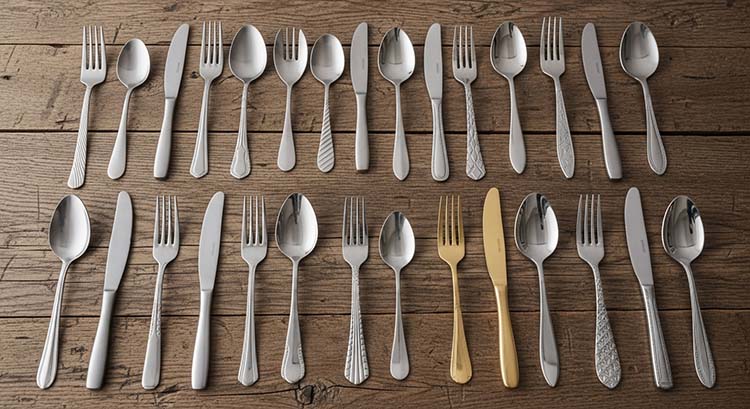
As a factory owner, I talk to restaurant managers and procurement specialists like Jacky every day. The most successful ones understand that flatware isn't just a tool; it's part of the experience. It's the one thing every single guest will hold. Choosing the right set is one of the most practical decisions you can make. It impacts everything from your brand image to your operational costs. Let's walk through the key decisions to make sure you get it right the first time.
What Pieces Do You Truly Need in a Restaurant Flatware Set?
Ordering flatware components is confusing and stressful. Order too many unnecessary pieces, and you waste money. Order too few, and your service looks unprepared and unprofessional.
Match your set components directly to your menu. For most restaurants, a 3-piece set (dinner fork, knife, spoon) is perfect. Fine dining may require a 5-piece set for multiple courses.
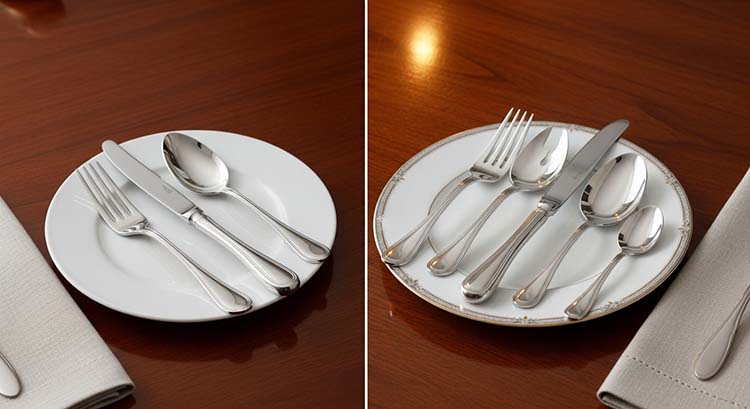
Don't buy what you don't need. The foundation of your decision should be your menu. There is no reason to have a fish fork if you don't serve whole fish. A five-star hotel I work with offers formal multi-course dinners, so they need a complete 5-piece setting: dinner fork, dinner knife, salad fork, soup spoon, and dessert spoon. It's expected. However, for the vast majority of restaurants—from casual bistros to busy buffets—a simple 3-piece set is more practical and cost-effective. You can always have specialized cutlery like steak knives available upon request. Keeping the table setting clean and simple with just the essential pieces often creates a better, less intimidating experience for the diner.
Common Set Configurations
| Restaurant Type | Recommended Set | Why It Works |
|---|---|---|
| Fine Dining | 5-Piece Set (Fork, Knife, Salad Fork, Soup Spoon, Teaspoon) | Meets expectations for formal, multi-course dining. |
| Casual Dining | 3-Piece Set (Dinner Fork, Dinner Knife, Teaspoon) | Covers all needs for a standard main course and drink. |
| Buffet / Quick Service | 2-Piece Set (Dinner Fork, Dinner Knife) | Provides the essentials for self-service while minimizing costs and cleanup. |
How Do You Match Cutlery Style to Your Restaurant's Theme?
Your restaurant has a unique theme and atmosphere. Using generic, boring flatware can shatter that illusion, making your carefully crafted experience feel cheap and incomplete.
The style of your flatware must be an extension of your brand. Choose elegant polished designs for fine dining, minimalist shapes for modern themes, and antique finishes for rustic settings.
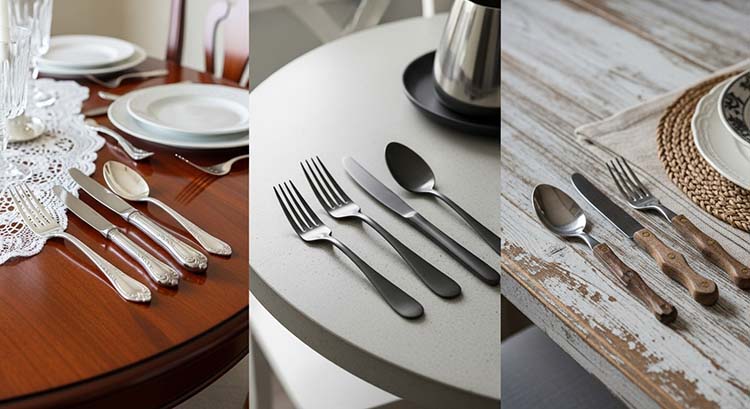
Your flatware should feel like it belongs. It's a key part of your table's landscape. A high-end steakhouse client of mine chose a heavy, oversized set with a mirror polish finish. The weight and shine immediately communicate quality and luxury before the food even arrives. In contrast, a trendy industrial-style cafe opted for a slender, matte black set. It perfectly matched their concrete walls and minimalist decor. The key is to see flatware as part of your decor, not just a utility. Think about the message you want to send. The shape, finish, and design details should all work together to tell your restaurant's story and make the guest feel they are in a special place.
| Restaurant Theme | Recommended Style | Finish |
|---|---|---|
| Fine Dining / Classic | Ornate, traditional patterns, heavy weight. | High-Shine Mirror Polish |
| Modern / Minimalist | Clean lines, simple geometric shapes. | Matte Black or Brushed Satin |
| Rustic / Farm-to-Table | Simple forms, naturalistic elements. | Stonewashed1 or Antique Finish |
| Theme (e.g., Coastal) | Unique shapes, custom colors or handles. | Polished or Custom Coated |
Does the Size and Weight of Your Flatware Actually Matter?
You might think all forks are basically the same. But when a customer gets a tiny, flimsy fork to eat a hearty pasta dish, their experience is immediately frustrating.
Yes, size and weight matter immensely. A heavier, larger "dinner size" flatware feels balanced and signals quality. Lighter, smaller pieces can feel cheap and are functionally worse for main courses. The heft in hand is a direct measure of quality.
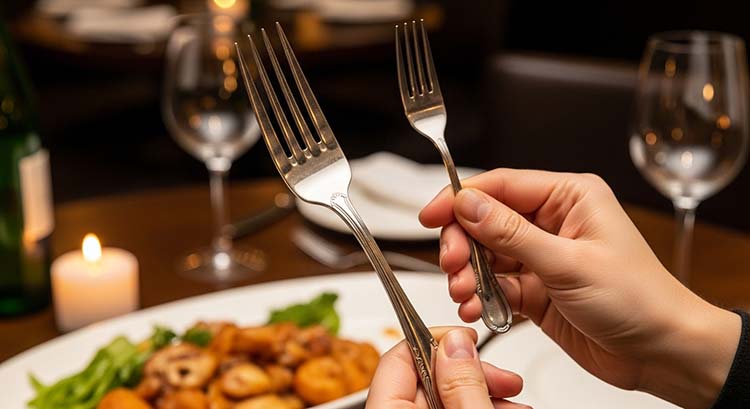
In the flatware industry, we often talk about "European size" versus "American size." European-sized flatware is typically larger and heavier. This is what you often find in high-end restaurants. The heft and balance feel substantial and luxurious in the hand. Smaller, lighter "luncheon" sized pieces are less expensive but can feel flimsy and less satisfying to use for a main meal. I always advise my clients to hold the samples themselves. How does it feel? Does it feel balanced or is the head too heavy for the handle? A well-balanced piece of cutlery feels like a natural extension of the hand. This subtle ergonomic detail has a huge, unconscious impact on how a guest perceives the quality of your entire operation. Don't underestimate the power of a good handshake or a well-balanced fork.
| Feature | Premium "Dinner" Size | Budget "Luncheon" Size |
|---|---|---|
| Weight | Heavier, more substantial heft. | Lighter, can feel flimsy. |
| Size | Larger, longer pieces (e.g., Fork > 8 inches). | Smaller, shorter pieces. |
| Perception | Signals quality, luxury, and value. | Can feel cheap or inadequate for main courses. |
| Best For | Main courses in most dining establishments. | Light lunches, desserts, or cost-focused venues. |
How Do You Balance Quality and Budget When Buying Flatware?
Your budget is tight, and cutting costs is a priority. But buying cheap flatware that rusts or bends after a few months means you just have to buy it all over again.
Think of flatware as a long-term investment. For premium durability, choose 18/10 stainless steel. For a great budget-friendly and still reliable option, choose 18/0 stainless steel. The initial savings from cheaper materials are rarely worth it.
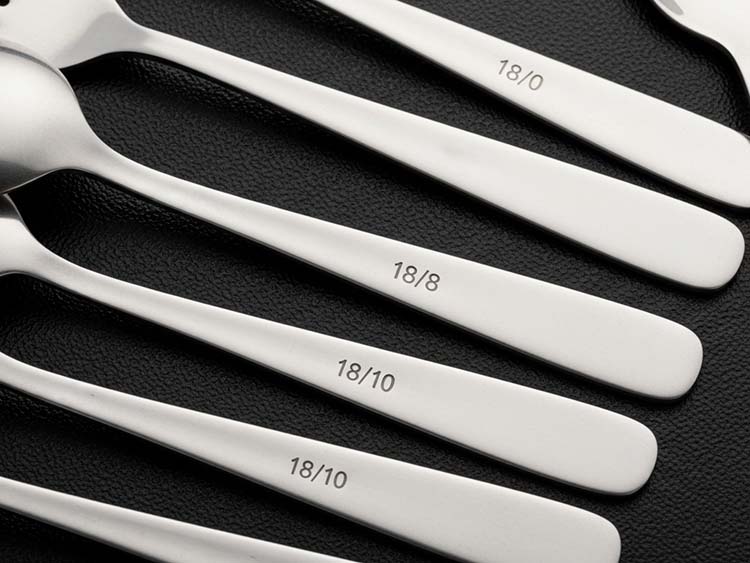
This is the most critical decision for your bottom line. The choice comes down to two main types of stainless steel: 18/102 and 18/0. The numbers refer to the percentage of chromium and nickel in the alloy. Nickel is the expensive ingredient that provides superior protection against rust and corrosion from acids in food and harsh dishwashing detergents. 18/10 (or 304 stainless steel) is the gold standard. It costs more upfront but will last for years, even with heavy commercial use. 18/0 (or 430 stainless steel) has no nickel, so it's much more affordable. It's a solid choice for high-volume, casual restaurants where pieces might get lost frequently, but it is more susceptible to rust over time. I always ask my clients to calculate the total cost of ownership3. The cheap set you replace every two years will cost you far more than the quality set you buy once.
| Feature | Premium (18/10 or 304 Steel) | Budget-Friendly (18/0 or 430 Steel) |
|---|---|---|
| Composition | ~18% Chromium, ~10% Nickel | ~18% Chromium, 0% Nickel |
| Rust Resistance | Excellent | Good, but can rust with harsh detergents. |
| Durability | Highest, very resistant to bending. | Good, but softer than 18/10. |
| Initial Cost | Higher | Lower |
| Best For | Fine dining, any restaurant wanting a long-term investment. | High-volume casual dining, buffets, budget-focused operations. |
Conclusion
Choosing the right flatware means aligning your brand, menu, and budget. By selecting the right components, style, and material, you create a better guest experience and make a smart investment.
-
Explore this link to discover how stonewashed finishes enhance aesthetics and durability in restaurant settings. ↩
-
Explore the advantages of 18/10 stainless steel to understand why it's considered the gold standard for durability and rust resistance. ↩
-
Learn how to calculate total cost of ownership to make informed decisions that save money in the long run. ↩
